O2 Systems during WW2
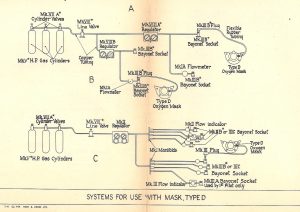 Left – This is a schematic diagram of a basic oxygen system fitted to military aircraft. If you follow the diagram from the 3 relatively small oxygen cylinders, you will see the O2 line goes through a simple line valve and then to the O2 regulator, which obviously changed and got better as time passed. From the regulator, the O2 was fed to a union coupling where the pilot would plug his bayonet O2 hose fitting in to feed the O2 mask. In this system, there was also a flow meter. In basic high altitude flying up to around 20,000 feet, the rule of thumb would be 1 litre per second per 10,000 feet however, that is a basic rule which allows you to calculate the bare minimum quantity of O2 required.
Left – This is a schematic diagram of a basic oxygen system fitted to military aircraft. If you follow the diagram from the 3 relatively small oxygen cylinders, you will see the O2 line goes through a simple line valve and then to the O2 regulator, which obviously changed and got better as time passed. From the regulator, the O2 was fed to a union coupling where the pilot would plug his bayonet O2 hose fitting in to feed the O2 mask. In this system, there was also a flow meter. In basic high altitude flying up to around 20,000 feet, the rule of thumb would be 1 litre per second per 10,000 feet however, that is a basic rule which allows you to calculate the bare minimum quantity of O2 required.
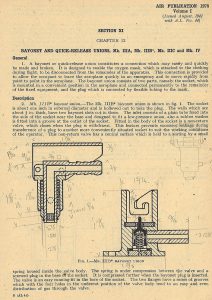
Right – Oxygen was supplied by a constant flow system and entered the mask by a breathing tube (before 1941 insulated by cloth wrapping) anding in an “L” shaped bayonet connector Mk IIIB (6D/101) plugged into the main oxygen supply. Looks like some engineer has made size notes on this publication to machine another one! The next schematic shows the Mk VIIIA* o2 regulator and the later Mk X regulator.
On most of the fighter aircraft, I have seen evidence suggesting that the female attachment point for the male Bayonet connector was on the starboard side of the cockpit just above the undercarriage selector lever on the Spitfire.
Oxygen Masks
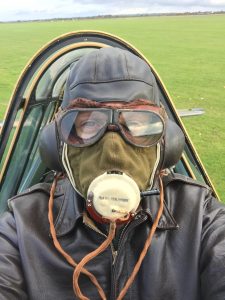 O2 Masks and Helmets – As the height in which air operations were conducted increased during the First World War, it was found that aircrew experienced oxygen starvation above 10,000 feet. Some developments in the provision of oxygen were made at this time, but such equipment was very rare, and most aviators had to carry on without it.
O2 Masks and Helmets – As the height in which air operations were conducted increased during the First World War, it was found that aircrew experienced oxygen starvation above 10,000 feet. Some developments in the provision of oxygen were made at this time, but such equipment was very rare, and most aviators had to carry on without it.
During the early inter-war period, only high-altitude weather observers and some record-breaking fliers used oxygen. By the mid-1930s however, advances in aircraft performance meant that both the supply of oxygen and the ability to communicate with fellow crew members while wearing masks were essential.
D & E, E*, G,H Type masks
The type D fabric masks were developments of the early A and B type masks which had served throughout the 20s and 30s. Their variants only consisted of adding different microphones and lasted until 1941.
D MASK
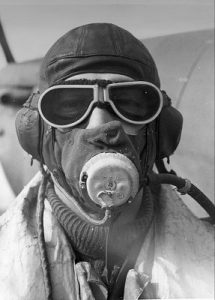
D Type Mask left – Flight Lieutenant P S Turner of No. 242 Squadron RAF, wearing his B-type flying helmet and D type Oxygen mask; he is also wearing the RAF-issued MkII flying goggles, which were the inter-war era goggles.
This mask has the “Type 19 Microphone Electro-Magnetic, Stores Ref: 10A/10989”. The Type 19 microphone included a Q Loom. Type 18 was the microphone minus the Loom. “Type 18 Electro-magnetic microphone: stores ref 10A/10990”.
The D Mask – All of the early masks were of the “constant flow” type, with oxygen being fed to the mask continuously. This, however, was wasteful and unnecessary as the breathing cycle consists of one-third inhalation and two-thirds exhalation. Furthermore, only part of the inhaled air needs to be oxygen. “Constant flow” systems, ,required three times more oxygen in heavy cylinders to be carried than was necessary. In 1941 therefore, a new generation of masks was introduced.
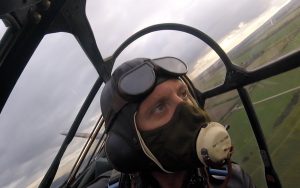
Type D was developed and introduced in the mid-1930s and remained in use well into WWII until being superseded in 1941 and finally declared obsolete in 1942. Similar in design and appearance to the type B mask, the main differences lay in the attachment method to the flying helmet. This should be accomplished by means of four stud fasteners, female on the helmet and male on the mask. In order to prevent freeze-burn to the wearer at high altitudes (and consequently low temperatures) the mask’s snap fasteners were to be attached by means of a pair of « face defenders » (Ref. No. 22C/68) issued with the flying helmet, i.e. chamois backed webbing strips with the males already affixed. So far the intended official way executed by the station Taylor.
Photographic evidence however shows many non-standard ways of attaching the mask to the helmet. Snap fasteners, webbing straps, elasticized and spring goggle straps and all sorts of available and (more or less) effective means were used, leaving almost no limits to the ingenuity of the fitter or wearer – who often was the same person…
Below some footage I put together with Masks through the ages 1940 – 1945 in the Harvard ‘The Wacky Wabbit”
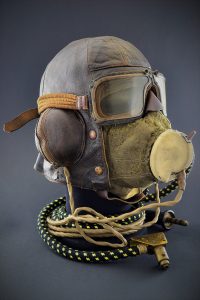 D Mask with carbon mic – While the Ref. No. 6D/105 represents the “mask assembly” as a whole, every single component had its own designation. The Type D mask body (6D/106) made of green wool barathea was lined with chamois. Between the two, a layer of linen insulation and cardboard stiffene,r together with a length of flexible wire gave the mask its shape for a more secure fit. The interior included a horse-shoe shaped padded cushion intended to provide some sealing against the face. The front opening was sewn to a black pained metal ring (6D/117) which contained the oxygen inlet ant to which the microphone was to be attached. Oxygen was supplied by a constant flow system and entered the mask by a breathing tube (before 1941 insulated by cloth wrapping) anding in an “L” shaped bayonet connector Mk IIIB (6D/101) plugged into the main oxygen supply. (Credits Flight Gear – ch)
D Mask with carbon mic – While the Ref. No. 6D/105 represents the “mask assembly” as a whole, every single component had its own designation. The Type D mask body (6D/106) made of green wool barathea was lined with chamois. Between the two, a layer of linen insulation and cardboard stiffene,r together with a length of flexible wire gave the mask its shape for a more secure fit. The interior included a horse-shoe shaped padded cushion intended to provide some sealing against the face. The front opening was sewn to a black pained metal ring (6D/117) which contained the oxygen inlet ant to which the microphone was to be attached. Oxygen was supplied by a constant flow system and entered the mask by a breathing tube (before 1941 insulated by cloth wrapping) anding in an “L” shaped bayonet connector Mk IIIB (6D/101) plugged into the main oxygen supply. (Credits Flight Gear – ch)
The mask was issued without means of communication, the front opening being closed by a chamois-covered metal cap (6D7108), to be used with a hand or throat microphone (in the latter case, USAAF T-30 laryngoscopes in lend-lease aircraft).
Designed to be fitted with microphones, these were hinged to open from the bottom of the retaining ring, i.e. foan r easier conversation on the ground, secured by a spring catch at the top.
E Mask
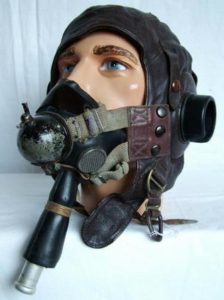
The E* mask – incorporated a duel valve to allow air to be inhaled with the oxygen supply and to permit exhalation. It was called Type E, and underwent various official and unofficial modifications to overcome its design faults. The last variant was the Type E* mask.Stores Ref. 6D/473 (redesignated 6D/624). This is the later pattern variant of the E-mask complete with anti-suffocation/inspiratory valve and having an elasticated webbing harness. type 27 carbon microphone. www.historicflyingclothing.com
At the same time the aircraft oxygen systems were modified by the addition of the Oxygen Economisers which fed a measured dose of oxygen to the aircrew rather than a constant flow. The simple boxed bellows mechanism was activated by the change in pressure at the start of the breathing in phase of the cycle. They were known as “Puffing Billies” because of the perceptible puff of oxygen which the aircrewman received. The economisers could of course, only be used with the new masks though the E mask could be used, with an adaptor, on the old constant flow system.
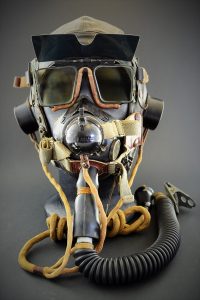
The arrival of the new generation of moulded rubber oxygen masks, replacing the now inadequate and obsolete Type D mask, called for an improvement in flying helmet design. The rather bulky Type B helmet of Battle of Britain fame had to slowly step aside for the Type C which was more streamlined and easier to mass produce due to its fewer parts. Arriving in 1941 the new design was to remain in service in different configurations for almost two decades, well into the jet age.
The rear-elasticized dark brown leather shell was lined with chamois and due to the contoured neck and brow allowed for greater movement of the head, improved noise insulation and increased wind resistence while providing a comfortable and snug fit. The first pattern of the Type C featured a leather chin strap with « Bennet « buckle, a rear centre buckled leather goggle retaining strap and four lateral (two on each side) further goggle retaining straps closed by means of stud fasteners.
Two stud fasteners on each side allowed a Type E oxygen mask to be fitted. Later three were fixed on the left side and a hook on the right to accommodate the more recent Type E*, Type G and Type H masks with their improved webbing harness straps. Earphones were to be inserted into sewn-on black rubber cups while kapok filled chamois rings (round shaped on the first series of helmets, then oval for improved sound insulation) allowed for more wearing comfort.
Thus the first series of Type C helmets were « unwired », as were all British flying helmets until 1944, with all radio communication stored seperately. When needed earphone receivers were simply popped into the « telephone holders » while the microphones for transmissions were integrated into the oxygen masks.
G Mask
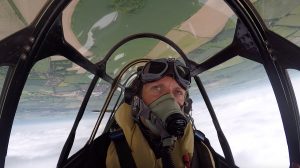
The G Mask – The Type E mask had a short life and were replaced in late 1942 by the type G. This pattern was made in a better, less perishable rubber composition, and the oxygen outlets were positioned high up inside the face-cup walls so that they didn’t ice up with condensation. (Modern picture – Andrew Goodall)
Type G oxygen mask – Stores Ref. No. 6D/643-645 (sizes L / M / S
When the Type G mask was eventually issued in adequate quantities from April 1943, it had been under development for almost exactly two years, and then remained in production until the end of WWII. Studies about the causes and effects of oxygen starvation, tests of raw materials and developments in rubber technology have accompanied this interim time.
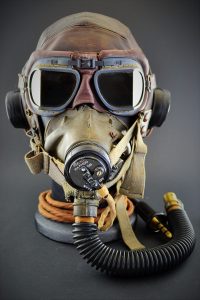 RAF C Type Helmet 2nd Pattern and G Mask – The new mask was welcomed by British aircrew as it was well designed, comfortable, practical and with increased longevity thanks to improved materials like the blended and cured rubber of the mask body. The latter was lined with suede and featured a shapable copper wire across the nose to guarantee an adequate and secure facial seal. Oxygen entered the mask via the corrugated Mk IV breathing tube (6D/528, which was attached by screwing onto a threaded connection and allowed easy replacement or removal) and molded tubular cheek channels. The expiratory valve was mounted above the inlet junction while the anti-suffocation valve can be found on the left.
RAF C Type Helmet 2nd Pattern and G Mask – The new mask was welcomed by British aircrew as it was well designed, comfortable, practical and with increased longevity thanks to improved materials like the blended and cured rubber of the mask body. The latter was lined with suede and featured a shapable copper wire across the nose to guarantee an adequate and secure facial seal. Oxygen entered the mask via the corrugated Mk IV breathing tube (6D/528, which was attached by screwing onto a threaded connection and allowed easy replacement or removal) and molded tubular cheek channels. The expiratory valve was mounted above the inlet junction while the anti-suffocation valve can be found on the left.
The Type 48 microphone assembly designed for internally wired helmets contained a Type 26 speaker unit and was directly connected by means of a double-prong female socket Type 453. (Credit Flight Gear-ch)
H Mask
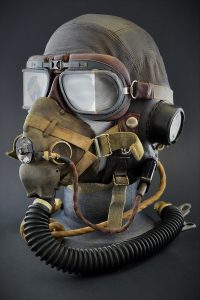
Type H oxygen mask. Stores Ref. No. 6D/814-816 (sizes L / M / S) Dated March 1945. With aircraft performance and complexity rapidly increasing towards the end of the war, lightweight construction, ease of mass production, wearing comfort and reliability of pilot equipment were of utmost importance.
The development of the Type H mask had all this on mind when it started in 1943, while the Type G was becoming operational. The grey rubber mask body, partially lined with suede, was short, light, compact and could live without external shaping wires. Being less bulky than its predecessor it allowed for improved head movements and down visibility. A light Type 57 micropone assembly saved further weight while an improved elastic harness arrangement, still using the “classic” stud fastener / hook / ring arrangement, provided an even more secure and airtight fit.
Inside, many characteristicslike valve arrangements and other components were taken over from its predecessor, effectively reducing the risk of freezing. Also the Mk IV breathing tube and attachment was retained.First examples appeared in 1944 and the Type H eventually became standard issue in early 1945. The design was so successful that it remained in frontline operational use for many years after the war.
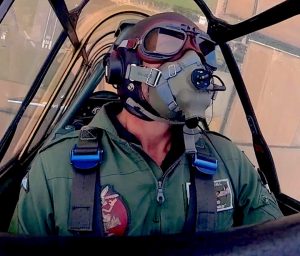 The H mask – The last mask used in the Second World War was the H mask which incorporated a smaller, lighter microphone. It was not widely used before the end of the war, being restricted to high altitude Photo-reconnaissance and metrological air crew. (Modern picture Andrew Goodall)
The H mask – The last mask used in the Second World War was the H mask which incorporated a smaller, lighter microphone. It was not widely used before the end of the war, being restricted to high altitude Photo-reconnaissance and metrological air crew. (Modern picture Andrew Goodall)
In my opinion having flown with all of the British war time set ups this combination of C Type Helmet and H mask with the MKVIII goggles work the best. There is no condensation build up in the mask and no fogging of the goggles. As the pilot the mask is the most comfortable being very light weight and the size of the mask is smaller around the chin than the G mask allowing the pilot to look down with no restrictions.
Advances in oxygen requirements during WW2
World War II-era physiologists helped solve physiological problems related to flight, research that helped pave the way for an Allied victory in the air, according to Jay B. Dean, of the University of South Florida College of Medicine.
Dr. Dean prepared a presentation on his historical research for April 7, at the Experimental Biology conference in San Diego. His presentation is entitled “High altitude physiology research and training platforms used by American physiologists during World War II: Innovative altitude chambers and high flying bomber aircraft.”
Some early highlights of World War II Aviation Research
- Dr. Randy Lovelace of the Mayo Clinic, a leader in aviation physiology research during the war, studied the opening shock of a parachute by jumping from a plane at 40,200 feet on a static line, which opened his parachute immediately upon jumping. The force of deceleration as Lovelace left the speeding B-17 and his chute opened, blew off his gloves and knocked him unconscious. One of his hands suffered frostbite as a result of the jump, but he recovered.
- Physiologists later experimented with 150-pound dummies to determine opening shocks at varying heights, from planes traveling varying speeds.
- Still later, physiologists trained a 145-pound St. Bernard dog, Major, to parachute — simulating the jump of a man. Major wore protective clothing and an oxygen mask and dog paddled during his descent.
Flight Still in Infancy
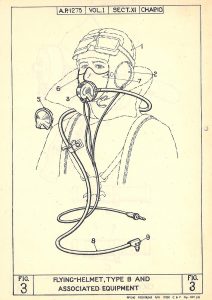 Air Ministry Publication 1275 – At the outset of the war, aircraft were neither pressurized nor heated, but air crews flew as high as possible to avoid ground fire and enemy fighters. Flying at 25,000-30,000 feet, roughly the height of Mount Everest, the crews suffered hypoxia from the lack of oxygen and decompression sickness from the low pressure, among other ills. Long range bombing missions could last for up to 8 to 10 hours under these grueling conditions.
Air Ministry Publication 1275 – At the outset of the war, aircraft were neither pressurized nor heated, but air crews flew as high as possible to avoid ground fire and enemy fighters. Flying at 25,000-30,000 feet, roughly the height of Mount Everest, the crews suffered hypoxia from the lack of oxygen and decompression sickness from the low pressure, among other ills. Long range bombing missions could last for up to 8 to 10 hours under these grueling conditions.
Physiologists performed numerous experiments in hypobaric chambers to resolve these problems. These sealed chambers, also called high altitude chambers, mimic the low oxygen and low pressure of high altitudes.
At the beginning of the war in Europe, when physiologists were anxious to get to work and there were only three high altitude chambers in the U.S., they briefly considered using the elevators in the Empire State Building to study rapid changes in pressure. That suggestion never came to fruition, and U.S. scientists were able to build enough high altitude chambers quickly to get the research underway.
Among the problems the physiologists were able to work out using altitude chambers
- Decompression sickness, in which nitrogen bubbles form in the blood and tissue, can be reduced by breathing pure oxygen before takeoff and during ascent. This reduces the amount of nitrogen in the blood and tissues and so reduces bubble formation. This technique is still used today, including by astronauts prior to a space walk.
- Fliers could survive rapid decompression of a pressurized airplane with enough time to put on an oxygen mask before losing consciousness. Planes had not been pressurized, in part because of concerns that fliers could not survive a rapid decompression.
- Fliers could withstand a rapid decompression as long as their airway was open, allowing air to flow out of their lungs as the surrounding ambient pressure dropped. If their airway was sealed, as during mid-swallow, then their lungs could “over-pressure” resulting in tearing of lung tissue.
Physiological research also helped develop
- Ways to safely provide pressurized oxygen to air crews, helping them avoid hypoxia and decompression sickness.
- Ways to develop better fitting oxygen masks to avoid fogging and freezing of goggles, common problems for pilots early in the war.
- Ways to prevent blood from pooling in the lower extremities using a G-suit during violent dog-fighting maneuvers, thereby preventing “blackout” and loss of consciousness due to lack of blood flow to the brain.
Source: Science daily